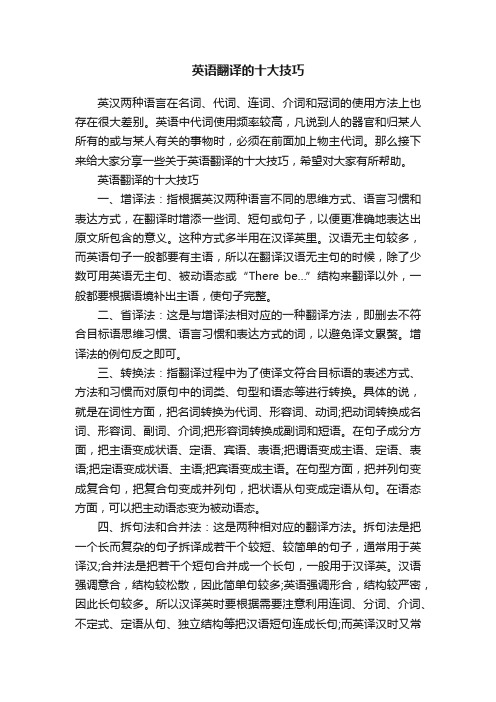Translation techniques(里面包含增译法,减译法,转译法,重复译法)
翻译的基本技巧

根据词的语法形式确定词义: by means of syntax
agreement 同意 an agreement 协定 people 人民 a people 民族 hostility 敌意 hostilities 战争 use 使用 uses 用途 work 工作 works 工厂、著作 advice 忠告 advices 通知 color 颜色 colors 颜色、旗帜
褒贬的引申
Edison invented the gramophone and the electric light. This kind of people sometimes invent excuses to go out of work. 爱迪生发明了留声机和电灯。 这种人有时编造借口不去上班。 He stole a glance at the pretty girl across the table. 他偷偷地看了看桌子对面那漂亮的女孩一眼。
Procedures of today:
Diction Conversion Exercises in class Assignments
Diction:
Diction refers to the proper choice of words and phrases in the process of translation to fit their context. E.g. Tension is building up. 形势紧张起来。 电压在加强。 张力在增大。 压力在增强。…… 红包 gift money/ bonus/ bribes
英汉互译增译法及省译法

英汉互译增译法及省译法Translating Techniques增译法&省译法u增词法就是在翻译时根据意义上或修辞上或句法上的需要增加原⽂中虽⽆其词但有其义的⼀些词。
u增词绝不是⽆中⽣有,不是随意增加原⽂没有的意义。
u Some metals are easy to machine; others are not.⼀些⾦属容易加⼯,⽽另⼀些却。
u增译的原则:不可添意,适可⽽⽌u You may wonder why the magnet's poles point north an south.u你也许感到好奇,为什么磁铁的极指向南北呢?1.Reading makes a full man; conference a ready man; and writingan exact man.2.We don’t regret, we never have and never will.3.After the basketball, he still has an important conference.1. Reading makes a full man; conference a ready man; and writing an exact man.读书充实,讨论机智,笔记(写作)使⼈准确。
2. We don’t regret, we never have and never will.我们不会后悔,我们从来没有,我们将来也不会。
3. After the basketball, he still has an important conference.看完篮球⽐赛之后,他还有⼀个重要会议。
1.With what enthusiasm the Chinese people are building socialism!2.The crowds melted away.3.As he sat down and began talking, words poured out.4.She lingered long over his letter.With what enthusiasm the Chinese people are building socialism! 中国⼈民正以热情建设社会主义啊!The crowds melted away.⼈群散开了。
常用翻译技巧之必备增译法省译法

专心翻译 做到极致常用翻译技巧之必备增译法省译法 英汉两种语言在句法、词汇、修辞等方面均存在着很大的差异,因此在进行英汉互译时必然会遇到很多困难,需要有一定的翻译技巧作指导。
常用的翻译技巧有增译法、省译法、转换法、拆句法、合并法、正译法、反译法、倒置法、包孕法、插入法、重组法和综合法等。
这些技巧不但可以运用于笔译之中,也可以运用于口译过程中,而且应该用得更加熟练,因为口译工作的特点决定了译员没有更多的时间进行思考。
增译法:指根据英汉两种语言不同的思维方式、语言习惯和表达方式,在翻译时增添一些词、短句或句子,以便更准确地表达出原文所包含的意义。
这种方式多半用在汉译英里。
汉语无主句较多,而英语句子一般都要有主语,所以在翻译汉语无主句的时候,除了少数可用英语无主句、被动语态或"Therebe…"结构来翻译以外,一般都要根据语境补出主语,使句子完整。
英汉两种语言在名词、代词、连词、介词和冠词的使用方法上也存在很大差别。
英语中代词使用频率较高,凡说到人的器官和归某人所有的或与某人有关的事物时,必须在前面加上物主代词。
因此,在汉译英时需要增补物主代词,而在英译汉时又需要根据情况适当地删减。
英语词与词、词组与词组以及句子与句子的逻辑关系一般用连词来表示,而汉语则往往通过上下文和语序来表示这种关系。
因此,在汉译英时常常需要增补连词。
英语句子离不开介词和冠词。
另外,在汉译英时还要注意增补一些原文中暗含而没有明言的词语和一些概括性、注释性的词语,以确保译文意思的完整。
总之,通过增译,一是保证译文语法结构的完整,二是保证译文意思的明确。
(1)What about calling him right away?马上给他打个电话,你觉得如何?(增译主语和谓语)(2)If only I could see the realization of the four modernizations.要是我能看到四个现代化实现该有多好啊!(增译主句)(3) Indeed, the reverse is true 实际情况恰好相反。
外国语毕业论文-简谈翻译技巧之—增译法与减译法

简谈翻译技巧之—增译法与减译法On Translation Techniques-----Amplification and OmissionHe YuLin何玉林Under the Supervision ofLiao HongSchool of Foreign Languages and CulturesPanzhihua UniversityMay 2006Contents摘要 (I)Abstract (II)Introduction (III)Chapter 1Brief Introduction (1)1.1The Definition of Translation. (1)1.2The Definition and Importance of the Two Techniques (1)Chapter 2Amplification and Omission. (3)2.1 Amplification (3)2.1.1 Structural Amplification (4)2.1.2 Semantic Amplification. (6)2.1.3 Rhetorical Amplification. (7)2.1.4 Exteriorized Amplification (7)2.1.5 Words Supplied for Syntactic Construction and Semantic Completion (8)2.1.6 Supplying the Omitted words in the Original Text in Translation (10)2.1.7 Supplying Category Words (10)2.1.8 Supplying Overlapping Words or Numerals to Express the Plural Form of Nouns (11)2.2Omission (12)2.2.1 English---Chinese Translation (13)2.2.2 Chinese---English Translation (16)Chapter3S imilarities between the Two Translation Techniques (19)Conclusion (21)Notes (22)Bibliography (23)Acknowledgement (24)摘要本文以翻译技巧------增译法和减译法为核心,详细论述了两种翻译技巧在翻译中的具体运用和作用。
英汉互译简明教程Translation Techniques

They live frugally to accumulate more funds for the state .
Note:不要进行字对字的死译。要考虑中英文的真正含义。
2021/7/17
10
II. Choice of Word Meanings According to Different Collocation.
英汉互译简明教程Translation Techniques
Translation Techniques
Generally speaking, the basic translation techniques that merit our attention and are to be applied in English-Chinese or ChineseEnglish translations include:
• The same word with the same part of speech may have different meanings due to different collocations.
For example: Delicate
Delicate skin Delicate porcelain Delicate upbringing Delicate living Delicate health Delicate stomach Delicate vase Delicate diplomatic question Delicate difference Delicate surgical operation
1.Diction(遣词用字) (重译法) (增译法) (减译法) (转换法) (词序调整法) (正说反译,反说正译法) 8.Change of Voices(语态变换法) (分译法) (合译法)
常用翻译技巧

常用翻译技巧英汉两种语言在句法、词汇、修辞等方面均存在着很大的差异,因此在进行英汉互译时必然会遇到很多困难,需要有一定的翻译技巧作指导。
常用的翻译技巧有增译法、省译法、转换法、拆句法、合并法、正译法、反译法、倒置法、包孕法、插入法、重组法和综合法等。
这些技巧不但可以运用于笔译之中,也可以运用于口译过程中,而且应该用得更加熟练,因为口译工作的特点决定了译员没有更多的时间进行思考。
1增译法:指根据英汉两种语言不同的思维方式、语言习惯和表达方式,在翻译时增添一些词、短句或句子,以便更准确地表达出原文所包含的意义。
这种方式多半用在汉译英里。
汉语无主句较多,而英语句子一般都要有主语,所以在翻译汉语无主句的时候,除了少数可用英语无主句、被动语态或“There be…”结构来翻译以外,一般都要根据语境补出主语,使句子完整。
英汉两种语言在名词、代词、连词、介词和冠词的使用方法上也存在很大差别。
英语中代词使用频率较高,凡说到人的器官和归某人所有的或与某人有关的事物时,必须在前面加上物主代词。
因此,在汉译英时需要增补物主代词,而在英译汉时又需要根据情况适当地删减。
英语词与词、词组与词组以及句子与句子的逻辑关系一般用连词来表示,而汉语则往往通过上下文和语序来表示这种关系。
因此,在汉译英时常常需要增补连词。
英语句子离不开介词和冠词。
另外,在汉译英时还要注意增补一些原文中暗含而没有明言的词语和一些概括性、注释性的词语,以确保译文意思的完整。
总之,通过增译,一是保证译文语法结构的完整,二是保证译文意思的明确。
如:(1)What about calling him right away?马上给他打个电话,你觉得如何?(增译主语和谓语)(2)If only I could see the realization of the four modernizations.要是我能看到四个现代化实现该有多好啊!(增译主句)(3)Indeed,the reverse is true实际情况恰好相反。
翻译笔记之八大技巧

翻译笔记之八大技巧Eight translation techniques1.增译法(amplification);2.重译法(repetition);3.减译法(omission);4.词类转移法(conversion);5.词序调整法(inversion):6.分译法(division);7.正说反译,反说正译(negation);8.语态变换法(the change of the voices)Group competition1.I am looking forward to the holidays.我在等待假日的到来.2.Much of our morality is customary.我们大部分的道德观念都有习惯性。
3.Courage in excess becomes foolhardiness,affection weakness,thrift avarice.勇敢过度,即成蛮勇;感情过度,即成溺爱;俭约过度,即成贪婪。
4. Histories make men wise;poets witty;the mathematics subtle;natural philosophy deep;moral grave;logic and rhetoric able to contend.读史使人明智,读诗使人灵秀,数学使人周密,科学使人深刻,伦理使人庄重,逻辑修辞使人善辩。
5. As an Oriental,I cannot but be proud of your historic achievement.作为一个东方人,我不得不为贵国所取得的历史性成就感到骄傲。
Amplification 增译法Three types: Semantic amplification,Grammatical amplification,Rhetoric amplificationSemantic amplification1. The crowds melted away人群渐渐散开了.2. We were all greatly moved by his loftiness.我们都被他那种崇高品质所深深感染.3. He felt the patriot rise within his breast.他感到一种爱国热情在胸中激荡.loftiness patriot: 英语习惯运用抽象词汇,而汉语习惯运用具体词汇将“抽象概念变为具体概念”,类似词汇如:arrogance, indifference, tension,confusion, solution, remedies, jealousy, fault-finding增补概括性的词1. The advantages of the meeting room are bright, spacious, fashionable, and without echoes.这个会议室有四大优点:明亮、宽敞、时髦、无回声。
英语翻译的十大技巧

英语翻译的十大技巧英汉两种语言在名词、代词、连词、介词和冠词的使用方法上也存在很大差别。
英语中代词使用频率较高,凡说到人的器官和归某人所有的或与某人有关的事物时,必须在前面加上物主代词。
那么接下来给大家分享一些关于英语翻译的十大技巧,希望对大家有所帮助。
英语翻译的十大技巧一、增译法:指根据英汉两种语言不同的思维方式、语言习惯和表达方式,在翻译时增添一些词、短句或句子,以便更准确地表达出原文所包含的意义。
这种方式多半用在汉译英里。
汉语无主句较多,而英语句子一般都要有主语,所以在翻译汉语无主句的时候,除了少数可用英语无主句、被动语态或“There be…”结构来翻译以外,一般都要根据语境补出主语,使句子完整。
二、省译法:这是与增译法相对应的一种翻译方法,即删去不符合目标语思维习惯、语言习惯和表达方式的词,以避免译文累赘。
增译法的例句反之即可。
三、转换法:指翻译过程中为了使译文符合目标语的表述方式、方法和习惯而对原句中的词类、句型和语态等进行转换。
具体的说,就是在词性方面,把名词转换为代词、形容词、动词;把动词转换成名词、形容词、副词、介词;把形容词转换成副词和短语。
在句子成分方面,把主语变成状语、定语、宾语、表语;把谓语变成主语、定语、表语;把定语变成状语、主语;把宾语变成主语。
在句型方面,把并列句变成复合句,把复合句变成并列句,把状语从句变成定语从句。
在语态方面,可以把主动语态变为被动语态。
四、拆句法和合并法:这是两种相对应的翻译方法。
拆句法是把一个长而复杂的句子拆译成若干个较短、较简单的句子,通常用于英译汉;合并法是把若干个短句合并成一个长句,一般用于汉译英。
汉语强调意合,结构较松散,因此简单句较多;英语强调形合,结构较严密,因此长句较多。
所以汉译英时要根据需要注意利用连词、分词、介词、不定式、定语从句、独立结构等把汉语短句连成长句;而英译汉时又常常要在原句的关系代词、关系副词、主谓连接处、并列或转折连接处、后续成分与主体的连接处,以及意群结束处将长句切断,译成汉语分句。
- 1、下载文档前请自行甄别文档内容的完整性,平台不提供额外的编辑、内容补充、找答案等附加服务。
- 2、"仅部分预览"的文档,不可在线预览部分如存在完整性等问题,可反馈申请退款(可完整预览的文档不适用该条件!)。
- 3、如文档侵犯您的权益,请联系客服反馈,我们会尽快为您处理(人工客服工作时间:9:00-18:30)。
❖ 英语和汉语在语法方面差异很大, 比如英语有数的 变化、有时态、语态、语气变化、有情态的变化 (我们常称为三态一气),而汉语这样的变化很少, 如时态,只用着、了、过就解决了。在翻译中我们 要注意这些差别, 把英语中的数和三态一气等体现 出来。为了使译文忠实地表达原文的意思与风格并 使译文合乎表达习惯,必须增加一些词语,这就叫增 译法.
❖ Let’s revise our safety and sanitary regulations. ❖ 我们来修改安全规则和卫生规则吧。
❖ Gentlemen may cry, peace, peace --- but there is no peace.
❖ 先生们尽管可以高呼和平,和平!但是依然没有和 平。
nothing. ❖ 他的那些孩子,也是穿得破破烂烂,粗野不堪,就象没有父
母似的。 ❖ His children, too, were as ragged and wild as if they
belonged to nobody.
Examples
❖ We have to analyze and solve problems. ❖ 我们要分析问题,解决问题。
1. Repetition(重复法)
❖ (3)为了生动重复
根据两种语言各自的习惯用法,以不同的 表达方式进行重复,这种重复通常是为了传达 原文的生动性.
❖ 汉语中有大量四字词组,这是汉语的一在特点。四 字词组比较精炼,念起来顺口,有节奏感,在英译 时要注意词汇的选择,尽量保留原文生动活泼的修 辞效果。例如:
1. Repetition(重复法)
❖ 他老是磨磨蹭蹭,马马虎虎,脾气又好得惊人,我们都对他 毫无办法。
❖ With his tardiness, careless and appalling good temper, we had nothing to do with him.
❖ 我的回答完全是坦坦荡荡,(直言无隐),不藏不掖。 ❖ I had been completely honest in my replies, withholding
❖ Nels had it all written out neatly. ❖ 纳尔斯把它写得清清楚楚。
Examples
这种人闹什么东西呢?闹名誉,闹地位,闹出风头。 What are they after? They are after name, after position, and they want to cut smart figure. 大(家庭)有大(家庭)的难处。 A large family has its difficulties. 天苍苍,野茫茫,风吹草低见牛羊。 The sky is blue, blue; And the steppe wide, wide; Over grass that the wind has battered low; Sheep and oxen roam.
青青河边草, 郁郁园中柳。 Green grows the grass upon the bank, The willow shoots are long and lank.
2. Amplification(增译法 /增词法)
❖ Amplification: It means supplying necessary
oriented lecturing Teaching Approaches: ❖ Multi-media aided. Teaching Procedures:
I. Discussion of the Assignment
Put the following paragraph into English: ❖ 今天的老人是昨天的劳动者。他们对物质文
使读者留下深刻印象,汉译英时往往可以采用同 样的重复手段。 ❖ 汉语原文中有词的重复,译成英语时可以保持同 样的词的重复。
1. Repetition(重复法)
例如: ❖ 他在凄雨中荡来荡去,想了又想,盘算了盘算。 ❖ He wandered about in the chill rain, thinking and thinking,
化的发展做出了许多贡献, 理所当然应该分 享其成果。当敬老、养老蔚然成风时, 各个 年龄层的人都会有一种完全感。每个人都有 一天会变老。 如果人们确信老年时生活一定 幸福、安康, 就会全力以赴地投入工作。
I. Discussion of the Assignment
❖ The old people of today are the laborers of yesterday. It goes without saying that they should have a share in the rewards for material and cultural advancements to which they have contributions. When respecting and providing for the elderly becomes common practice, people of all generations will have a sense of security. For everyone gets old some day, and when people feel perfectly secure of a happy and comfortable life in old age, they will devote themselves wholeheartedly to work.
brooding and brooding. ❖ 先生们尽管可以高喊和平,和平!但是依然没有和平。 ❖ Gentlemen many cry peace, peace---but there is no peace. ❖ 血债要用血来还。 ❖ Blood must atone for blood. ❖ 他们往往一遍又一遍反复琢磨这些密件。 ❖ They would read and re-read the secret notes.
II. Questions for discussion
1. What is domesticating? What is foreignizing?
Explain them through examples.
2. How do you understand the relationships between “free translation and literal translation” and “domesticating and foreignizing”? How do you use them in your translation practice?
1. Repetition(重复法)
重复也属于增词。翻译和写作一样。 本应力求简 练,尽量省略一些可有可无的词;有时为了明确、 强调或生动, 却往往需要将一些关键性的词加以 重复。例如: ❖ (1)为了明确重复
❖ 汉语重复,英译时也重复
❖ (2)为了强调重复 ❖ 为了强调,汉语句子中往往重复关键性的词,以
Eight Commonly-use repetition(重复法) 2. amplification(增译法 ) 3. omission(/省译法/减译法 ) 4. conversion(词类转移法 ) 5. inversion (词序调整法) 6. division(分译法) 7. negation(正说反译, 反说正译法) 8. the change of the voices(语态变换法)
III. Introduction to the techniques of translation
❖ Techniques of translation refer to the experience that people have accumulated in their practice of translation. They include lots of skills in translation, such as selection of word meaning, extension of word meaning, conversion of parts of speeches and sentence structures, long sentence translation, paragraph and passage translation, translation of articles of different kinds of styles, etc.
words in our translation work so as to make the version correct and clear. Words thus supplied must be indispensable either syntactically or semantically.
1. Repetition
❖ I. Teaching contents ❖ 1. 根据词义或修辞需要增词 ❖ 2. 根据语法需要增词 ❖ 3. 重复译法 ❖ 1) 为了明确重复 ❖ 2) 为了强调重复 ❖ 3) 为了生动重复
❖ IV. Teaching Method ❖ Discussion (group work, then class work). ❖ V. Teaching procedures
Teaching Plan
Teaching Aims: ❖ To make students get the knowledge of translation
techniques and master them in translating practicing. ❖ To make students skilled in translation. Teaching Focus: ❖ Training students’ ability in dealing with the techniques. Teaching Methods: ❖ Discussion (group work, then class work) and teacher-
